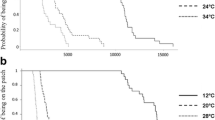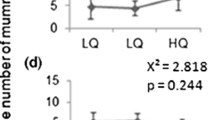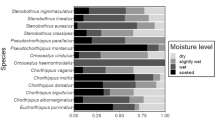Abstract
Searching patterns and oviposition success of the aphid parasitoid Aphidius rosae were analysed in different abiotic conditions (simulated wind, simulated drizzling rain, simulated shower, high temperature, low humidity, “standard conditions”) in the laboratory. Residence times, time allocation and oviposition success did not differ significantly between females foraging on rose shoots during periods with high temperature (>33°C) and low humidity (35%–40% relative humidity) and females searching under standard laboratory conditions (20°C, 65%–70% relative humidity, no wind). A wind speed of 2 m/s reduced the oviposition numbers significantly, and females spent much more time resting than searching for hosts. Females did not leave a shoot during wind, but departed quickly after wind had ceased. Simulated drizzling rain or simulated showers had the strongest effects on A. rosae foraging. Both types of rain prevented all foraging activities including departure from the shoot, and females laid no eggs during rain. After rain had stopped, females were mainly engaged with cleaning themselves and laid relatively few eggs compared to standard conditions. The impact of unfavourable abiotic environmental factors like wind or rain may help to explain why many parasitoids lay only a small proportion of their available eggs when foraging in the field.
Similar content being viewed by others
References
Abraham R (1975) Über die Wirkung der Temperatur auf die Flugaktivität parasitischer Hymenopteren. Z Angew Entomol 79: 113–123
Abraham R (1984) Die Flugaktivität von Coccigominus turionellae (Hym., Ichneumonidae) in Abhängigkeit von Temperatur und Bestrahlung. Z Angew Entomol 97: 192–201
Andow DA, Prokrym DR (1990) Plant structural complexity and host-finding by a parasitoid. Oecologia 82: 162–165
Bellows TS, Perring TM, Arakawa K, Farrar CA (1988) Patterns of diel flight activity of Bemisia tabaci (Homoptera: Aleyrodidae) in cropping systems in Southern California. Environ Entomol 17: 225–228
Campbell A (1974) Seasonal changes in abundance of the pea aphid and its associated parasites in the southern interior of British Columbia. PhD thesis, Simon Fraser University, Burnaby, BC
Casas J (1989) Foraging behavior of a leafminer parasitoid in the field. Ecol Entomol 14: 257–265
Casey TM (1981) Behavioural mechanisms of thermoregulation. In: Heinrich B (ed) Insect thermoregulation. Wiley, New York, pp 79–114
Chow A, Mackauer M (1991) Patterns of host selection by four species of aphidiid (Hymenoptera) parasitoids: influence of host switching. Ecol Entomol 16: 403–410
Comins HN, Hassell MP (1979) The dynamics of optimally foraging predators and parasitoids. J Anim Ecol 48: 335–351
Davies WM (1936) Studies on the aphids infesting the potato crop. V. Laboratory experiments on the effect of wind velocity on the flight of Myzus persicae Sulz.. Ann Appl Biol 23: 401–408
Delobel AGL, Lubega MC (1984) Rainfall as mortality factor in the Sorghum shootfly, Atherigona soccata Rond. (Diptera, Muscidae). Z Angew Entomol 97: 510–516
Deutscher Wetterdients (German Meteorological Survey) (1994) Monatliche Wetterdaten für die Station Bayreuth für die Monate Mai-Juli. DWD, Nürnberg
Fink U (1995) Der Einfluß unterschiedlicher abiotischer Faktoren auf das Suchverhalten und die Ressourcennutzung beim Blattlausparasitoiden Aphidius rosae. Diploma thesis, University of Bayreuth, Bayreuth
Force DC, Messenger PS (1964) Fecundity, reproductive rate and innate capacity of increase of three parasites of Therioaphis maculata (Buckton) reared at various constant temperatures. Ecology 45: 706–715
Fye RE, Poole HK (1971) Effect of high temperature on fecundity and fertility of six lepidopterous pest of cotton in Arizona. US Dept Agric Prod Res Rep 131: 1–8
Gardner SM, Dixon AFG (1985) Plant structure and the foraging success of Aphidius rhopalosiphi (Hymenoptera: Aphidiidae). Ecol Entomol 10: 171–179
Giga DP, Smith RH (1983) Comparative life-history studies of four Callosobruchus species infesting cowpeas with special reference to Callosobruchus rhodesianus (Pic) (Coleoptera: Bruchidae). J Stored Prod Res 19: 189–198
Gilbert N, Gutierrez AP (1973) A plant-aphid-parasite relationship. J Anim Ecol 42: 323–340
Godfray HCJ (1994) Parasitoids. Behavioral and evolutionary ecology. Princeton University Press, Princeton, NJ
Hassell MP (1978) The dynamics of athropod predator-prey systems. Princeton University Press, Princeton, NJ
Hassell MP (1986) Parasitoids and population regulation. In: Waage JK, Greathead D (eds) Insect parasitoids. Academic Press, London, pp 201–224
Hughes RD (1979) Rainfall as a cause of mortality in a dungbreeding fly. J Aust Entomol Soc 18: 323–327
Jordan S, Hubbard SF (1991) Influence of humidity and temperature on diel periodicity of oviposition of Toxorhynchites moctezuma (Diptera: Culicidae) in field. J Med Entomol 28: 241–245
Juillet JA (1960) Some factors influencing the flight activity of hymenopterous parasites. Can J Zool 38: 1057–1061
Juillet JA (1964) Influence of weather on flight activity of parasitic Hymenoptera. Can J Zool 42: 1133–1141
Kennedy JS (1990) Behavioural post-inhibitory rebound in aphids taking flight after exposure to wind. Anim Behav 39: 1078–1088
Mackauer M, Chow FJ (1986) Parasites and parasite impact on aphid populations. In: McLean GD, Garret RG, Ruesink WG (eds) Plant virus epidemics: monitoring, modelling and predicting outbreaks. Academia Press, Sydney, pp 95–117
Mackauer M, Kambhampathi S (1989) Multivariate assessment of inter- and intraspecific variation in performance criteria of several pea aphid parasites (Hymenoptera: Aphidiidae). Ann Entomol Soc Am 82: 314–324
Mackauer M, Stary P (1967) World Aphidiidae. Le Francois, Paris
Mackauer M, Völkl W (1993). Regulation of aphid populations by aphidiid wasps: does aphidiid foraging behaviour or hyperparasitism limit impact? Oecologia 94: 339–350
Maelzer DA (1977) The biology and main causes of changes in numbers of the rose aphid Macrosiphum rosae (L.) on cultivated roses in South Australia. Aust J Zool 25: 269–284
Maini S, Burgio G, Carrieri M (1991) Trichogramma maidis host searching in corn vs. pepper. Redia 74: 121–127
Miskimen GW (1970) Population dy dynamics of the yellow sugarcane aphid, Sipha flava, in Puerto Rico, as affected by heavy rains. Ann Entomol Soc Am 63: 642–645
Möller F (1973) Einführung in die Meteorologie. Wissenschafts-verlag, Mannheim Wien Zürich
Moran VC, Hoffmann JH (1987) The effect of simulated rainfall on cochineal insects (Homoptera: Dactylopiidae): colony distribution and survival on cactus cladodes. Ecol Entomol 12: 61–68
Moran VC, Hoffman JH, Basson NCJ (1987) The effect of simulated rainfall on cochineal insects (Homoptera: Dactylopiidae): colony composition and survival on cactus cladodes. Ecol Entomol 12: 51–60
Porter K (1983) Multivoltinism in Apanteles bignelli and the influence of weather on synchronisation with its host Euphydryas aurinia. Entomol Exp Appl 34: 155–162
Price PW (1973) Reproductive strategies in parasitoid wasps. Am Nat 107: 684–693
Price PW (1974) Strategies for egg production. Evolution 28: 76–84
Price PW (1975) Reproductive strategies of parasitoids. In: Price PW (ed) Evolutionary strategies of parasitoids. Plenum Press, New York, pp 87–111
Roitberg BD, Sircom J, Roitberg CA, van Alphen JJM, Mangel M (1993) Life expectancy and reproduction. Nature 364: 108
Rosenheim J (1994) Foraging behaviour of entomophagous insects. Plenary lecture. 10th International Workshop on Entomophagous Insects, Whistler, BC, 18–22 September 1994
Sappington TW, Showers WB (1983) Effects of precipitation and wind on population of adult European corn borer (Lepidoptera: Pyralidae). Environ Entomol 12: 1193–1196
Sekhon BS, Singh S (1985) Effect of temperature, relative humidity and rainfall on the population build-up of the cotton jassid. Indian J Ecol 12: 293–298
Stadler B, Völkl W (1991) Foraging patterns of two aphid parasitoids, Lysiphlebus testaceipes and Aphidius colemani on banana. Entomol Exp Appl 58: 221–229
Stary P (1970) Biology of aphid parasites, with respect to integrated control. (Series Entomology 6) Junk, Den Haag
Stary P (1973) A review of the Aphidius species (Hymenoptera: Aphidiidae) in Europe. Ann Zool Bot 84: 1–85
Stern DL, Dudley R (1991) Wing buzzing by male orchid bees, Eulaema meriana (Hymenoptera: Aphidae). J Kansas Ent Soc 64: 88–94
Van Rensburg JBJ, van Rensburg GDJ, Giliomee JH, Walters MC (1987) The influence of rainfall on the seasonal abundance and flight activity of the maize stalk borer, Busseola fusca in South Africa. S Afr J Plant Soil 4: 183–187
Vanwoerkom GJ, Turpin FT, Barrett JR (1983) Wind effect on western corn rootworm (Coleoptera: Chrysomelidae) flight behaviour. Environ Entomol 12: 196–200
Varley GC, Gradwell GR, Hassell MP (1973) Insect population ecology. An analytical approach. Blackwell, Oxford
Vet LEM, van Alphen JJM (1984) A comparative functional approach to host detection behaviour in parasitic wasps. I. A qualitative study on Eucoilidae and Alysiinae. Oikos 44: 478–486
Völkl W (1991) Species-specific larval instar preferences and aphid defense reactions in three parasitoids of Aphis fabae. In: Polgar L, Chambers R, Dixon AFG and Hodek I (eds) Behaviour and impact of aphidophaga. SPB Academic, The Hague, pp 73–78
Völkl W (1992) Aphids or their parasitoids: who actually benefits from ant-attendance? J Anim Ecol 61: 273–281
Völkl W (1994) Searching at different spatial scales: the foraging behaviour of the aphid parasitoid Aphidius rosae in rose bushes. Oecologia 100: 177–183
Walker GP, Cameron PJ (1981) The biology of Dendrocerus carpenteri (Hymenoptera: Ceraphronidae), a parasite of Aphidius species, and field observations of Dendrocerus species as hyperparasites of Acyrthosiphon species. NZ J Zool 8: 531–538
Walters KFA, Dixon AFG (1984) The effect of temperature and wind on the flight activity of cereal aphids. Ann Appl Biol 104: 17–26
Weisser WW (1994) Age-dependent foraging behaviour and hostinstar preference of the aphid parasitoid Lysiphlebus cardui. Entomol Exp Appl 70: 1–10
Weisser WW, Houston AI, Völkl W (1994) Foraging strategies in solitary parasitoids: the trade-off between female and offspring mortality risks. Evol Ecol 8: 587–597
Wiskerke JSC, Vet LEM (1994) Foraging for solitary and gregariously feeding caterpillars: a comparsion of two related parasitoid species (Hymenoptera: Braconidae). J Insect Behav 7: 585–603
Zwölfer H, Bauer G, Heusinger G, Stechmann DH (1984) Die tierökologische Bedeutung and Bewertung von Hecken. BerANL, Laufen, Beih 2: 1–155
Author information
Authors and Affiliations
Rights and permissions
About this article
Cite this article
Fink, U., Völkl, W. The effect of abiotic factors on foraging and oviposition success of the aphid parasitoid, Aphidius rosae . Oecologia 103, 371–378 (1995). https://doi.org/10.1007/BF00328627
Received:
Accepted:
Issue Date:
DOI: https://doi.org/10.1007/BF00328627




